
Allan Cunningham was an English botanist and explorer, primarily known for his travels in Australia to collect plants.

Nothofagus, also known as the southern beeches, is a genus of 43 species of trees and shrubs native to the Southern Hemisphere in southern South America and Australasia. The species are ecological dominants in many temperate forests in these regions. Some species are reportedly naturalised in Germany and Great Britain. The genus has a rich fossil record of leaves, cupules, and pollen, with fossils extending into the late Cretaceous period and occurring in Australia, New Zealand, Antarctica, and South America. In the past, they were included in the family Fagaceae, but genetic tests revealed them to be genetically distinct, and they are now included in their own family, Nothofagaceae.
A Flora is a book or other work which describes the plant species occurring in an area or time period, often with the aim of allowing identification. The term is usually capitalized to distinguish it from the use of "flora" to mean the plants rather than their descriptions. Some classic and modern Floras are listed below.

Allan Charles Wilson was a Professor of Biochemistry at the University of California, Berkeley, a pioneer in the use of molecular approaches to understand evolutionary change and reconstruct phylogenies, and a revolutionary contributor to the study of human evolution. He was one of the most controversial figures in post-war biology; his work attracted a great deal of attention both from within and outside the academic world. He is the only New Zealander to have won the MacArthur Fellowship.
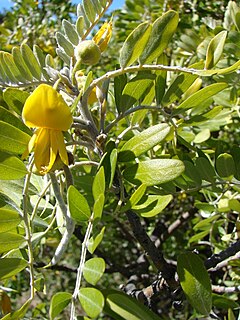
Sophora is a genus of about 45 species of small trees and shrubs in the pea family Fabaceae. The species are native to southern Asia, Australasia, various Pacific islands, western South America, the western United States, Florida and Puerto Rico. The generic name is derived from sophera, an Arabic name for a pea-flowered tree.

Coprosma is a genus of flowering plants in the family Rubiaceae. It is found in New Zealand, Hawaiian Islands, Borneo, Java, New Guinea, islands of the Pacific Ocean to Australia and the Juan Fernández Islands.
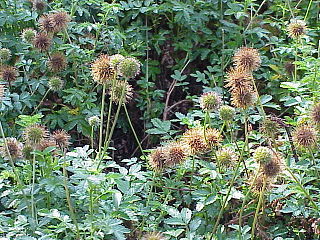
Acaena is a genus of about 60 species of mainly evergreen, creeping herbaceous perennial plants and subshrubs in the family Rosaceae, native mainly to the Southern Hemisphere, notably New Zealand, Australia and South America, but with a few species extending into the Northern Hemisphere, north to Hawaii and California.

Coriaria is the sole genus in the family Coriariaceae, which was described by Linnaeus in 1753. It includes 14 species of small trees, shrubs and subshrubs, with a widespread but disjunct distribution across warm temperate regions of the world, occurring as far apart as the Mediterranean region, southern and eastern Asia, New Zealand, the Pacific Ocean islands, and Central and South America.
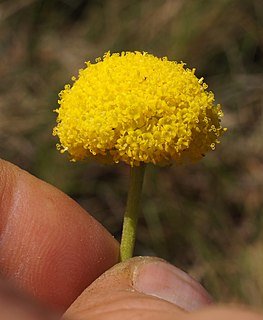
Craspedia is a genus of flowering plants in the daisy family commonly known as billy buttons and woollyheads. They are native to Australia and New Zealand where they grow in a variety of habitats from sea level to the Alps. The genus is found in every state of Australia except the Northern Territory. In New Zealand, Craspedia is found from East Cape on the North Island south to Stewart Island. It also occurs on Campbell Island and the Chatham Islands.

Muehlenbeckia or maidenhair is a genus of flowering plants in the family Polygonaceae. It is native to the borders of the Pacific, including South and North America, Papua New Guinea and Australasia. It has been introduced elsewhere, including Europe. Species vary in their growth habits, many being vines or shrubs. In some environments, rampant species can become weedy and difficult to eradicate.
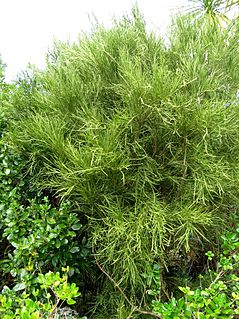
Carmichaelia is a genus of 24 plant species belonging to Fabaceae, the legume family. All but one species are native to New Zealand; the exception, Carmichaelia exsul, is native to Lord Howe Island and presumably dispersed there from New Zealand.
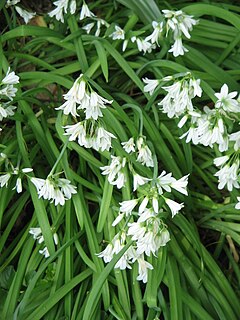
Allium triquetrum is a bulbous flowering plant in the genus Allium native to the Mediterranean basin. It is known in English as three-cornered leek, and in Australia and New Zealand as onion weed. Both the English name and the specific epithet triquetrum refer to the three-cornered shape of the flower stalks.
Arthur Allan Thomas is a New Zealand man who was granted a Royal Pardon and compensation after being wrongfully convicted of the murders of Harvey and Jeannette Crewe in June 1970. Thomas was married and farming a property in the Pukekawa district, south of Auckland before the case. Following the revelation that the crucial evidence against him had been faked, Thomas was pardoned and awarded NZ$950,000 in compensation for his 9 years in prison and loss of earnings.
The New Zealand Plant Conservation Network (NZPCN) is a non-governmental organisation devoted to the protection and restoration of New Zealand's indigenous plant life, including vascular plants, mosses, liverworts, hornworts and lichens.

Hebe stricta, commonly called koromiko, is a flowering plant in the family Plantaginaceae, which is endemic to New Zealand. Recently Hebe stricta has been reclassified and the botanical name has changed to Veronica stricta.

Lucy Beatrice Moore was a New Zealand botanist and ecologist.

Roderick Leon Bieleski was a New Zealand plant physiologist.
The Australasian Virtual Herbarium (AVH) is an online resource that allows access to plant specimen data held by various Australian and New Zealand herbaria. It is part of the Atlas of Living Australia (ALA), and was formed by the amalgamation of Australia's Virtual Herbarium and NZ Virtual Herbarium. As of 12 August 2014, more than five million specimens of the 8 million and upwards specimens available from participating institutions have been databased.
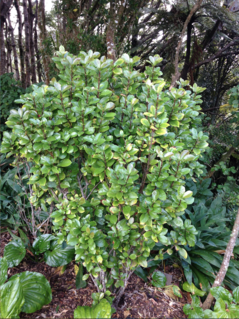
Alseuosmia quercifolia, commonly known as Oak-leaved toropapa, toropapa, and karapapa (Māori), is a species of plant in the family Alseuosmiaceae. It grows as a shrub, reaching a height of 2.5 m, and has variably shaped glossy green leaves. Flowering begins in spring, producing fragrant pink flowers which become red berries in Autumn. Endemic to New Zealand, it is found only in the upper half of the North Island - predominately in the Waikato region.

Neopanax laetus, the shrub panax, is a species of flowering plant in the subfamily Aralioideae, family Araliaceae, native to the North Island of New Zealand. It has gained the Royal Horticultural Society's Award of Garden Merit.
















